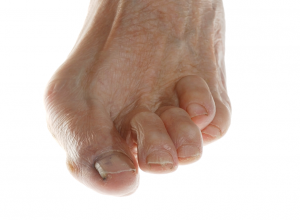
Brachymetatarsia
QUICK FACTS
- Brachymetatarsia is characterized by one or more metatarsal bones in the foot being shorter than usual; it usually affects the fourth metatarsal bone
- It is more commonly seen in women than in men
- Causes include trauma, injury or illness, but brachymetatarsia can also be congenital, meaning it's a deformity present at birth
- Symptoms range from mild to severe pain on the bottom of the foot, but most people feel nothing at all
- Treatment usually includes physical therapy to strengthen the feet, wearing orthotics and taking over-the-counter pain medication; surgery is a rare treatment option
About Brachymetatarsia
Brachymetatarsia, also referred to as hypoplastic metatarsal, is a foot condition in which one or more of the metatarsal bones are shorter than usual. It most often affects the fourth metatarsal bone, resulting in an abnormally short forth toe.
Causes
Brachymetatarsia can be due to a congenital defect, meaning it’s present at birth, or it may be an acquired condition resulting from trauma injury or illness. When congenital, causes often include Aarskog syndrome and Apert syndrome, which can halt the metatarsal bones from fully developing.
For reasons unknown, brachymetatarsia seems to affect more women than men. It is also common in people with Psuedophypoparthyroidism and Downs syndrome.
Symptoms
Brachymetatarsia is often characterized by one or more toes appearing significantly shorter than the others. As mentioned above, it is usually the fourth toe that appears much shorter that the rest of the toes on the foot. In some cases, it may look as if the fourth toe is elevated, with the third and fifth toes touching each other underneath. Brachymetatarsia is usually first noticed in early childhood, when the bones are developing.
Most people do not feel any pain related to brachymetatarsia, but some do feel toe discomfort and/or pressure on the bottom of the foot, especially if the deformity changes the contour of the ball of the foot. In some cases, wearing shoes can be uncomfortable and painful pressure calluses develop.
Treatment
As with most foot conditions, podiatrists and orthopaedic surgeons will first suggest conservative, non-surgical treatments for brachymetatarsia. These suggestions might include wearing wider shoes with additional padding or arch support, wearing orthotics, engaging in physical therapy to strengthen the foot muscles and taking non-steroidal anti-inflammatory medications (NSAIDs).
If the above treatments don’t relieve foot pain, or if a patient would like to treat brachymetatarsia for cosmetic reasons, metatarsal lengthening surgery is an option. The procedure often includes cutting the short metatarsal bone and grafting a piece of bone from another part of the body between the two ends, but the metatarsal could also be lengthened with an external fixator that contains a screw that turns and gradually lengthens the bone.
The recovery period following surgery for brachymetatarsia is typically about two to three months with the patient needing crutches or a knee scooter to keep weight off the foot during that time.
Notice concerning medical entries:
Articles having medical content shall serve exclusively for the purpose of general information. Such articles are not suitable for any (self-) diagnosis and treatment of individual illnesses and medical indications. In particular, they cannot substitute for the examination, advice, or treatment by a licensed physician or pharmacist. No replies to any individual questions shall be effected through the articles.






